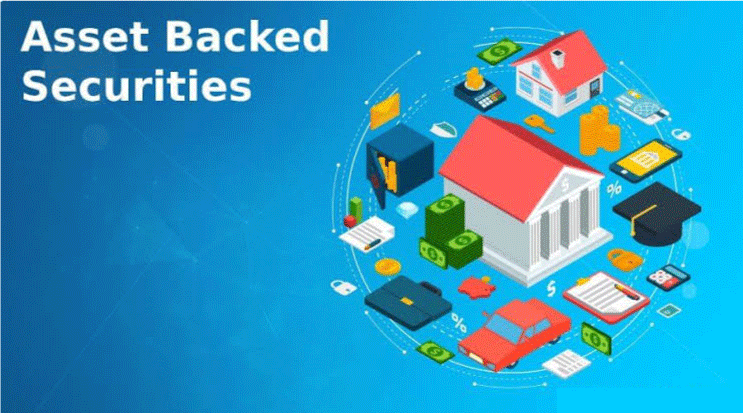Asset-Backed Security (ABS): What It Is, How Different Types WorkWhat is an Asset-Backed Security (ABS)?A pool of underlying assets that acts as a security or a capital commitment, known as asset-backed security (ABS), often represents those financial investments that generate working capital from debt, such as loans, leasing, balances on credit cards, or invoices. It takes the shape of a contract or note that will pay interest at a predefined rate for a predetermined period until maturity. Asset-backed securities can substitute for other debt products, such as corporate bonds or stock funds, for income-seeking investors. 
Understanding Asset-Backed Security (ABS)Asset-backed securities give their issuers the ability to raise money for lending or other investments. An ABS's underlying assets are frequently illiquid and cannot be sold separately. Securitization, combining assets to create a financial instrument, enables the issuer to sell illiquid assets to investors. Additionally, it enables them to remove riskier assets from their books, lowering their credit risk. These pools' underlying assets might include credit card debt, vehicle loans, school loans, home equity loans, or other forms of anticipated cash flows. ABS issuers are free to use any inventiveness they choose. For instance, asset-backed securities have been developed using cash flows from cinema ticket sales, royalties, aeroplane parking slots, tolls, and solar photovoltaics. Almost any event or instrument that generates revenue may be secured into an ABS. Purchasing an ABS offers the potential for a revenue source for investors. The ABS enables individuals to participate in a wide range of revenue assets, even occasionally-as was already mentioned-exotic ones that aren't accessible through any other kind of investing. How does an Asset-Backed Security work?Let's say Company X lends money for cars as a company. Company X lends money to someone who wishes to borrow funds to purchase a car, with the condition that they pay the loan back with a specific interest rate. Perhaps Company X issues so many debts that it begins to have cash flow problems. In such a case, Company X can collaborate with Investment Firm X and sell its current loans, receiving cash in return. The cash obtained from this sale of Company X's present loans to Investment Company X can subsequently be used to fund the creation of new loans. The loans will subsequently be divided into several portions known as tranches by investment firm X. Loans in these tranches are comparable in terms of maturity, rate of interest, and anticipated default rate. Then, based on each portion it develops, Investment firm X will issue securities. Each ABS has a rating similar to bonds, showing how risky it is or how likely it is that the underlying loans would default. The free cash flow from the fundamental pool of vehicle loans is subsequently distributed to individual investors who bought these bonds; it is distributed after deducting the administrative charge that Investment Company X keeps for itself. Special ConsiderationsThree tranches-class A, class B, and class C-are often present in an ABS. Almost often, the senior tranche, A, is the largest portion and is designed to evaluate the profitability to appeal to investors. Since the B portion has a lesser credit rating than the senior tranche, its yield is greater. The C portion may not be able to be offered to investors since it has a worse credit quality than the B portion and a lower credit score. In this scenario, the issuer would maintain the C part and pay the losses. Types of Asset-Backed Security
Technically, anything that creates an income stream, such as electricity bills or loans for mobile homes, can be turned into asset-based security (ABS). But some are more typical than others. The most prevalent ABS includes: Collateralized Debt Obligation (CDO)An ABS produced by a special purpose vehicle (SPV) is known as a CDO. A company or trust created especially to issue such ABS is the SPV. There are several different categories of CDOs, including:
Although a CDO and an ABS are structurally similar, some people view them as different kinds of financial vehicles. CDOs often possess a bigger and more varied array of assets, such as other asset-based securities or CDOs. Home Equity ABSOne of the main subcategories of ABSs is home equity loans. Although comparable to mortgages, home equity loans are frequently obtained by borrowers who could not receive a mortgage because they needed better credit or limited assets. These loans are amortizing, which means that each payment is divided into three categories: interest, principle, and prepayments. Credit Card Receivables ABSSince their introduction in 1987, securities backed by credit card receivables have served as the benchmark for the ABS market. Up to the authorized credit limit, credit card members may borrow money on a revolving basis. The borrowers then pay the desired principle and interest payments in addition to the minimum monthly payments. Credit card debt is regarded as a non-amortizing loan since principal repayments are not planned; hence it needs a real maturity date. Credit card-backed ABS receivables are issued by trusts that have developed from separate to multiple kinds of master trusts, with the de-linked master trust being the most prevalent. Discrete trusts are made of senior and subordinated bonds tranched from a defined or stationary source of receivables. As the count of receivables increases, a master trust has the benefit of providing various transactions, each of which is liable to a pro-rata part of all the receivables. The de-linked structures enable the issuer to divide the trust's senior and junior series and deliver them at various times. Instead of a single static pool, the latter two types let investors profit from a bigger pool of loans over time. Student LoansStudent loan-collateralized ABS is one of the four main investment vehicles funded by asset-backed securitizations and serves as a model for several variable rate indexes. The U.S. Dept. of Education guarantees Federal Family Education Loan Program (FFELP) loans, the most popular type of student loan, at rates between 95% and 98%. Productivity has traditionally been quite strong, and investors have had exceptional rates of return. The CCRA Act went into effect on October 1, 2007, drastically altering FFELP loans' economics. Payments for special allowances were decreased, the excellent performance label was removed, lender insurance costs were lowered, and lender-paid origination costs were increased. Even though the FFELP loan program ended in 2010, there were still 11 million borrowers owing over $245 billion as of 2020. Private student loans, often known as non-FFELP loans, make up a second and faster-expanding segment of the student loan sector. Although the student loan reform mentioned above modestly raised the borrowing limits for some FFELP loan types, the largely unchanged lending restrictions for FFELP loans and rising tuition are pushing students to look for other lenders. Students use private loans to cover the difference between the amount they may borrow via government programs and the leftover cost of their education. Auto LoansAuto loans are the ABS market's second-largest sub-segment. Companies that finance cars issue securities with pools of loans backing them up. Prime, nonprime, and subprime are the three classifications for auto ABS.
The most typical loan structure for vehicle loans is an owner trust, which enables investors to collect interest and principal promptly. Additionally, deals can be designed to pay pro rata or in a balance of the two. Impact of Asset-Backed SecurityDue to their reputation as safe investments, many investors view ABS as appealing investment options. They are rated similarly to other securities based on their capacity to collect interest and principal payments on schedule. Since these bonds are secured and collateralized, it is more likely that debt obligations will be met. ABS is one of the most reliable investment options in terms of credit. Furthermore, ABS provides security from potential risk by backing these securities with their underlying assets. Investors frequently prefer them to corporate bonds since, regardless of how highly regarded the bond may be, a certain occurrence might force the rating agency to decrease its ratings. A merger, acquisitions, restructuring, or reorganization of the company are a few examples of these developments. The diversity that an ABS provides is another advantage of investing in one. Since ABS cover a wide range of business sectors, investors may extend their fixed-income profile. However, there are some dangers associated with investing in ABS. Investors occasionally bear the danger of being paid in advance. This implies that when a borrower increases their payment plan, it can lower the working capital investors observe. In the circumstances of dropping interest rates, this frequently occurs. Investors may also be exposed to risk if the borrowers fail to make their loan instalments. Money may not enter the security as intended if borrowers can no longer pay back their loans. Consequently, it might offer the investor more profit than they hoped for. Securitization of AssetsSecuritization is the practice of pooling loans and other types of debt to generate asset-backed securities. Auto loans, mortgages for homes and businesses, credit card debt incurred by consumers, and student loans are just a few examples of the various loan kinds that might be securitized. 
Since each asset-backed security only comprises a portion of each underlying asset, the risk of default is reduced. At the same time, the initial interest and principal amount are carried on to the shareholders. Based on both the risk and return factors, each pool is divided. Riskier investments may offer a larger return, while lesser-risk assets may lead to lower interest payments. What is Asset Backing?The total worth of a company's earnings in proportion to its reserves is referred to as asset backing. It specifically refers to the sum of all a firm's assets divided by the total number of shares the firm has granted that are still outstanding. When referring to investments, the word "asset backing" describes a bond whose value is derived from a single property or a collection of shares; these holdings serve as bonds for the security, so "backing" it. Benefits of Asset-Backed Security1. Safeguards Against Potentially Unsafe Lending The advantage for the lenders is that potentially hazardous loans are taken off their income statement since they have been packaged and sold to outside shareholders as asset-backed securities. They can also get a new source of cash that they can utilize to make more loans or for other company requirements by obtaining the value through asset-backed securities. 2. Offers a More Reliable Alternative for an Investment Vehicle Asset-backed securities offer investors a different investment instrument with better rates and sustainability than government securities. Asset-backed securities also provide an opportunity for investors who wish to diversify their portfolios across markets. Despite this, not all investors can make direct loans to individuals via credit and debit cards or mortgages. 3. Reduces the Chance of Default and Other Credit Problems Shareholders can get interest and principal payments on various assets without having to create them by purchasing asset-backed securities. The danger of defaults and other credit risks is reduced since each bond only includes a small portion of the underlying securities. Drawbacks of Asset-Backed Security1. Absence of Attentiveness Security may have hundreds of underlying assets when investors buy them. Completing significant studies might make it easier to assess the credit hazard of the underlying assets. Retail investors might not be able to perform such a thorough investigation, which could expose them to unanticipated dangers. 2. Lessening of Prepayment Yield Pre-payment risks, which happen when the lenders of the underlying funds choose to return their debts early, may also apply to asset-backed securities. It can lead to a reduced yield for securities holders. 3. Possible Mass Defaults during a Recession If the underlying assets are past due, certain dangers may exist. The default risk is spread among various assets because each bond only holds a portion of each underlying asset. But in a recession, the security may see numerous defaults if the financial assets are of poor quality. Asset-Backed Security and Financial Crisis
Many banks launched mortgage-backed securities (MBS), often referred to as asset-backed securities, during the 2008 Global Financial Crisis. The assets were supported by bad mortgages with a significant likelihood of failure, although many investors were not aware of this. Banks issued a huge quantity of bonds without any regulatory control at the time since the securities were not regulated. The largest rating agencies then assigned the securities AA or AAA ratings, making them secure investments. Many investment firms bought the assets without being familiar with the default risk that lay beneath, including pension funds. The mortgage-backed securities market collapsed due to the borrowers' inability to make payments and subsequent default on their loans, wiping away billions of dollars in the value of stocks. What is the difference between MBS and ABS?A mortgage-backed security (MBS) and asset-Backed security (ABS) are comparable. Both are types of securities that, like typical securities, are backed by a pool of income-producing assets, often debts or loans, and pay a fixed interest rate. The primary distinction is that an MBS, as its title indicates, comprises a collection of mortgages. On the other hand, an ABS is typically supported by other forms of debt, such as credit card debt, vehicle loans, or education loans. When referring to securitized investments based on underlying asset pools, certain capital resources often use the word "ABS" as a general term. In this situation, an MBS is a type of ABS. Some people distinguish between ABSs and MBSs as independent investment instruments. How does asset securitization work?Securitizing an asset starts when a lender (or any corporation with loans) or a business with income-producing assets selects a number of them and then makes plans to sell the whole group to an investment banking company. A special-purpose vehicle (SPV), which is an organization created especially to buy capital, organize them and release them as a single security. It is frequently established by the institution after pooling the respective assets with equivalent ones from various distributors. Then, the issuer offers these securities to buyers, who are often institutional buyers. A trustee account supported by the working capital produced by the asset portfolio pays the investors at fixed or variable rates. The issuer may occasionally cut up the initial asset portfolio into units known as tranches. Each tranche is offered independently and carries a unique level of risk, which is reflected in its credit rating. |
 For Videos Join Our Youtube Channel: Join Now
For Videos Join Our Youtube Channel: Join Now
Feedback
- Send your Feedback to [email protected]
Help Others, Please Share









